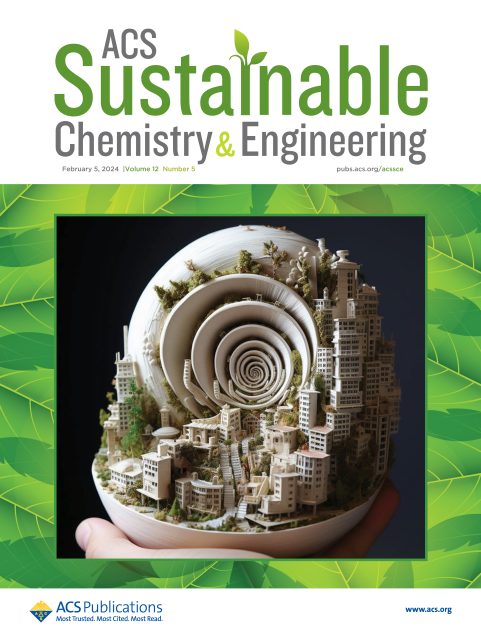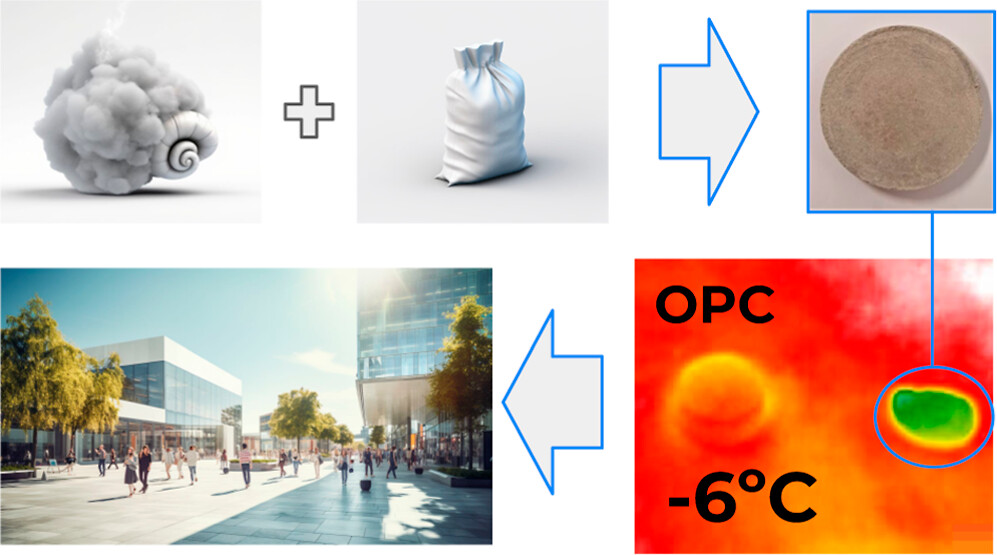Sea snails for mitigating urban heat island effects.
The urban heat island effect has become a critical issue in urban areas, intensifying heat-related problems and increasing energy consumption.

Urban areas tend to experience higher temperatures compared to those of surrounding rural areas, this is known as the urban heat island effect. The elevated temperature in cities is primarily attributed to the high density of paved and roofed surfaces, such as roads, sidewalks, and building roofs, which absorb and retain heat. This phenomenon leads to increased energy consumption for cooling, reduced human comfort, and adverse impacts on the local environment and biodiversity.
In recent years, various strategies have been proposed to mitigate the effects of UHI, including the use of green roofs, blue infrastructures, and cool pavements and roofs. Regarding this last strategy, studies are mainly centered on the development of reflective coatings and thermochromic materials. However, these solutions have several limitations that hinder their widespread adoption. For instance, many reflective surfaces and cool roof membranes have a relatively short lifespan and require frequent maintenance, while the installation and maintenance costs of green roofs can be substantial.
In this context, the utilization of sustainable construction materials with high solar reflectivity and emissivity in the atmospheric window can enhance the overall energy performance of buildings while reducing maintenance needs. Moreover, such a cost-effective approach not only contributes to the reduction of carbon emission associated with energy consumption for cooling purposes but also addresses the carbon footprint during their production.
One promising solution for sustainable construction is the use of carbonated concrete, which involves converting carbon dioxide (CO2) into a solid mineral that can be permanently stored, preventing its release into the atmosphere. This process has the potential to play a crucial role in reducing greenhouse gas emissions and mitigating global warming.Carbon capture processes have proven to be effective for both fresh and hardened Portland cement, resulting in significant improvements in the mechanical properties of the resulting cementitious materials. Additionally, the utilization of recycled concrete or artificial aggregates offers an opportunity to store CO2 and mitigate the carbon dioxide emissions associated with cement production.
By incorporating highly solar reflective carbonated aggregates into the concrete matrix, sustainable construction materials that not only sequester CO2 but also possess desirable reflective properties can be developed. Now, a team of researchers has studied 1 the reflective properties of an innovative cool cementitious composite that incorporates a novel carbonated aggregate derived from recycled Periwinkle shells.

Periwinkles are a type of sea snail commonly found worldwide, and their shells primarily consist of portlandite and calcite. Through a carefully controlled carbon capture process, the researchers were able to transform the Periwinkle shell ash into carbonated aggregates. In fact, the strong reactivity with carbon dioxide of portlandite, and its subsequent conversion to calcite (Ca(OH)2 + CO2 → CaCO3 + H2O), is a well known process.
The resulting carbonated Periwinkle shell ash was mixed with ordinary Portland cement at a ratio of 70 wt % ash, leading to the production of a reflective concrete. This proportion was deliberately chosen to align with the typical aggregate content, encompassing both coarse and fine components commonly employed in standard concrete mixes.
Remarkably, this cool concrete captured approximately 18 wt % of its weight in carbon dioxide and achieved a competitive solar reflectance index of 73. To evaluate the performance as a cool material, a comparative experiment was conducted on a sunny day. The samples were tested alongside standard cement paste samples on a rooftop under a solar power radiation ranging from 580 to 980 W/m2 for a duration of 7 h. The results demonstrated the excellent performance of the concrete with carbonated aggregate as it effectively reduced the maximum surface temperature by 6 °C. This reduction is comparable to that by the state-of-the-art reflective pavements, highlighting the potential of carbonated aggregates as an effective solution for mitigating urban heat island effects.
It is important to highlight the simplicity and scalability of this carbon capture process. The method employed in the study presents an exceptionally straightforward approach to convert carbon dioxide to a stable mineral form. This streamlined process holds tremendous promise for widespread implementation in sustainable construction practices, offering an accessible solution to the critical issue of carbon emissions.
Author: César Tomé López is a science writer and the editor of Mapping Ignorance
Disclaimer: Parts of this article may have been copied verbatim or almost verbatim from the referenced research paper/s.
References
- Guido Goracci, Ebtisam Saeed, Mary B. Ogundiran, Amaia Iturrospe, Arantxa Arbe, Cyril Aymonier, and Jorge S. Dolado (2024) Cool Concrete Incorporating Carbonated Periwinkle Shell: A Sustainable Solution for Mitigating Urban Heat Island Effects ACS Sustainable Chem. Eng. doi: 10.1021/acssuschemeng.3c05817 ↩